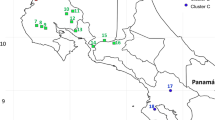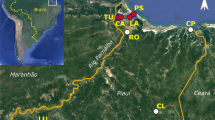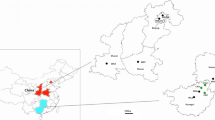Abstract
The population genetic patterns of a species at its range limits have important implications for species conservation. Geographically marginal populations are expected to have lower genetic diversity and higher genetic differentiation than geographically central populations. Nypa fruticans is a mangrove palm which is widely distributed from tropical to subtropical zone of Southeast Asia and Oceania. For N. fruticans, Iriomote Island in Japan represents the most northern limit of the distribution of the species. We examined the genetic variation based on 11 microsatellite markers from all 137 known ramets of N. fruticans on Iriomote Island in comparison with the more central population. Adult ramets on Iriomote Island were composed entirely of one multilocus genotype in each population and had no genetic diversity within the populations. The formation of each population by vegetative propagation from only one immigrant individual was considered to be the method of reproduction. In addition, the new juvenile which were found on the opposite side of the island possessed different alleles from other ramets in the island. This indicates that the transfer of a new genotype from another location abroad can take place. The analyses provided useful information for the continued monitoring of the demography and genetic status of these populations.

Similar content being viewed by others
References
Arnaud-Haond S, Teixeira S, Massa SI, Billot C, Saenger P, Coupland G, Duarte CM, Serrao EA (2006) Genetic structure at range edge: low diversity and high inbreeding in Southeast Asian mangrove (Avicennia marina) populations. Mol Ecol 15:3515–3525
Choi H-J, Kaneko S, Yokogawa M, Song G-P, Kim D-S, Kang S-H, Suyama Y, Isagi Y (2013) Population and genetic status of a critically endangered species in Korea, Euchresta japonica (Leguminosae), and their implications for conservation. J Plant Biol 56:251–257
Cultural Assets Conservation Committe Ryukyu Governmant (1960) A list of cultural assets (in Japanese). Cultural Assets Conservation Committe, Ryukyu Governmant
Davison GWH, Ng PKL, Chew HH (2008) The Singapore red data book: threatened plants and animals of Singapore. Nat Soc, Singapore
Dorken ME, Eckert CG (2001) Severely reduced sexual reproduction in northern populations of a clonal plant, Decodon verticillatus (Lythraceae). J Ecol 89:339–350
Duke NC, Meynecke JO, Dittmann S, Ellison AM, Anger K, Berger U, Cannicci S, Diele K, Ewel KC, Field CD, Koedam N, Lee SY, Marchand C, Nordhaus I, Dahdouh-Guebas F (2007) A world without mangroves? Science 317:41–42
Eckert CG (2001) The loss of sex in clonal plants. Evol Ecol 15:501–520
Eckert CG, Samis KE, Lougheed SC (2008) Genetic variation across species’ geographical ranges: the central-marginal hypothesis and beyond. Mol Ecol 17:1170–1188
Ellison J, Koedam NE, Wang Y, Primavera J, Jin Eong O, Wan-Hong Yong J, Ngoc Nam V (2010) Nypa fruticans. http://www.iucnredlist.org. Accessed 28 October 2014
Ellstrand NC, Elam DR (1993) Population genetic consequences of small population size: implications for plant conservation. Annu Rev Ecol Syst 24:217–242
Environmental Agency of Japan (2012) Red list of threatened plants of Japan. Environmental Agency of Japan. http://www.biodic.go.jp/english/rdb/rdb_f.html
Frankham R (1995) Conservation genetics. Annu Rev Genet 29:305–327
Fu LK, Jin JM (1992) China plant red data book—rare and endangered plants, vol 1. Science Press, Beijing
Goudet J (2002) Fstat v2. 9.3. 2. Université de Lausanne, Lausanne, Switzerland. http://www2.unil.ch/popgen/softwares/fstat.htm
Islam MS, Lian CL, Kameyama N, Hogetsu T (2014) Low genetic diversity and limited gene flow in a dominant mangrove tree species (Rhizophora stylosa) at its northern biogeographical limit across the chain of three Sakishima islands of the Japanese archipelago as revealed by chloroplast and nuclear SSR analysis. Plant Syst Evol 300:1123–1136
Izuno A, Takamiya M, Kaneko S, Isagi Y (2012) Genetic variation and structure of the endangered Lady Fern Athyrium viridescentipes based on ubiquitous genotyping. J Plant Res 125:613–618
Jian S, Ban J, Ren H, Yan H (2010) Low genetic variation detected within the widespread mangrove species Nypa fruticans (Palmae) from Southeast Asia. Aquat Bot 92:23–27
Kaneko S, Abe T, Isagi Y (2013) Complete genotyping in conservation genetics, a case study of a critically endangered shrub, Stachyurus macrocarpus var. prunifolius (Stachyuraceae) in the Ogasawara Islands, Japan. J Plant Res 126:635–642
Miyagi T, Hayashi K, Saito A, Baba S (2004) Survey of mangrove area changes in Okinawa Islands for monitoring coastal ecosystems by sea-level rise (in Japanese). International Society for Mangrove Ecosystems, Okinawa
MOE (2012) The national red list 2012 of Sri Lanka; conservation status of the fauna and flora. Ministry of Environment of Sri Lanka, Colombo
Nakanishi H, Ishii T (2010) Change of tropical drift fruits and seeds on the coast of Japanese mainland over a 40 year period (in Japanese with English abstract). J Japan Driftological Soc 8:7–11
Nakazato N, Hanashiro Y, Goto K (1996) Study on the Nypa fruticans Wurmb. in Okinawa I. The present state of the natural growth (in Japanese with English abstract). Proc Sch Agric Kyushu Tokai Univ 15:49–54
Niijima Y, Shinjo K, Miyagi K, Maezu E, Higoshi K, Shinnou Y (1983) Nypa population at Funaura, Iriomote Island (in Japanese). In: Education Committee of Okinawa Prefecture (ed) Urgent report on natural monuments in the Iriomote Island I. pp 41–49
Nishihira M (1980) Intertidial zone on Iriomote Island 1978 (in Japanese). Nature Conservation Division Okinawa Prefectural Government, Okinawa
Parks JC, Werth CR (1993) A study of spatial features of clones in a population of bracken fern, Pteridium aquilinum (Dennstaedtiaceae). Am J Bot 80:537–544
Peakall R, Smouse PE (2006) GENALEX 6: genetic analysis in Excel. Population genetic software for teaching and research. Mol Ecol Notes 6:288–295
Peck JR, Yearsley JM, Waxman D (1998) Explaining the geographic distributions of sexual and asexual population. Nature 391:889–892
Pei S, Chen S, Guo L, Henderson A (2010) Arecaceae (Palmae). In: Wu Z, Raven P, Hong D (eds) Flora of China, vol 23. Science Press and Missouri Botanical Garden Press, Beijing and St. Louis, pp 132–157
Polidoro BA, Carpenter KE, Collins L, Duke NC, Ellison AM, Ellison JC, Farnsworth EJ, Fernando ES, Kathiresan K, Koedam NE, Livingstone SR, Miyagi T, Moore GE, Vien Ngoc N, Ong JE, Primavera JH, Salmo SG III, Sanciangco JC, Sukardjo S, Wang Y, Yong JWH (2010) The loss of species: mangrove extinction risk and geographic areas of global concern. PLoS One 5(4):e10095
Sandoval-Castro E, Muniz-Salazar R, Enriquez-Paredes LM, Riosmena-Rodriguez R, Dodd RS, Tovilla-Hernandez C, Arredondo-Garcia MC (2012) Genetic population structure of red mangrove (Rhizophora mangle L.) along the northwestern coast of Mexico. Aquat Bot 99:20–26
Schupp EW, Fuentes M (1995) Spatial patterns of seed dispersal and the unification of plant population ecology. Ecoscience 2:267–275
Setoguchi H, Watanabe K, Takaso T, Nakazato N, Tobe H (1999) Genetic diversity of the natural monument Nypa fruticans (Palmae) at Funaura, Iriomote Island. Acta Phytotaxonomica et Geobotanica 50:201–205
Shinzato T, Kashima M (2006) Nypa fruticans Wurmb (in Japanese). In: Nature Conservation Division Department of Cultural and Environmental Affairs Okinawa Prefectural Government (ed) Threatened wildlife in Okinawa, 2nd ed (fungi and plants), Red data Okinawa. Nature Conservation Division, Department of Cultural and Environmental Affairs, Okinawa Prefectural Government, Okinawa, pp 211–212
Spalding M, Kainuma M, Collins L (2010) World atlas of mangroves. Earthscan, London
Sydes MA, Peakall R (1998) Extensive clonality in the endangered shrub Haloragodendron lucasii (Haloragaceae) revealed by allozymes and RAPDs. Mol Ecol 7:87–93
Taberlet P, Luikart G (1999) Non-invasive genetic sampling and individual identification. Biol J Linn Soc 68:41–55
Tomlinson PB (1971) The shoot apex and its dichotomous branching in the Nypa Palm. Ann Bot 35:865–879
Tomlinson PB (1994) The botany of mangroves. Cambridge University Press, Cambridge
Waits LP, Luikart G, Taberlet P (2001) Estimating the probability of identity among genotypes in natural populations: cautions and guidelines. Mol Ecol 10:249–256
Weir BS, Cockerham CC (1984) Estimating F-statistics for the analysis of population-structure. Evolution 38:1358–1370
Wright S (1946) Isolation by distance under diverse systems of mating. Genetics 31:39–59
Zhang ZH, Zhou RC, Tang T, Huang YL, Zhong Y, Shi SH (2008) Genetic variation in central and peripheral populations of Excoecaria agallocha from Indo-West Pacific. Aquat Bot 89:57–62
Acknowledgments
We thank Mr. Mikio Kashima for assistance in the collection of the plant material. We are also grateful to Dr. Goro Kokubugata (National Museum of Nature and Science, Japan), Ms. Auriea Lopez-Feliciano (Isabela State University, the Philippines) and Ms. Mina L. Labuguen (Community Environment and Natural Resources Office, the Philippines) for their assistance in the collection of plant materials in the Philippines. We also thank Dr. Tohru Naruse (University of the Ryukyus, Japan) and two anonymous reviewers for their valuable discussions and helpful supports on this article. This study was partly supported by a Grant-in-Aid for Encouragement of Scientists from the Japan Society for the Promotion of Science (KAKENHI, no. 24923005) to S.I and the Environment Research and Technology Development Fund (S9) of the Ministry of the Environment, Japan to Y.S.
Author information
Authors and Affiliations
Corresponding author
Additional information
Kyoko Sugai and Shin Watanabe have contributed equally to this work.
Rights and permissions
About this article
Cite this article
Sugai, K., Watanabe, S., Kuishi, T. et al. Extremely low genetic diversity of the northern limit populations of Nypa fruticans (Arecaceae) on Iriomote Island, Japan. Conserv Genet 17, 221–228 (2016). https://doi.org/10.1007/s10592-015-0773-6
Received:
Accepted:
Published:
Issue Date:
DOI: https://doi.org/10.1007/s10592-015-0773-6




